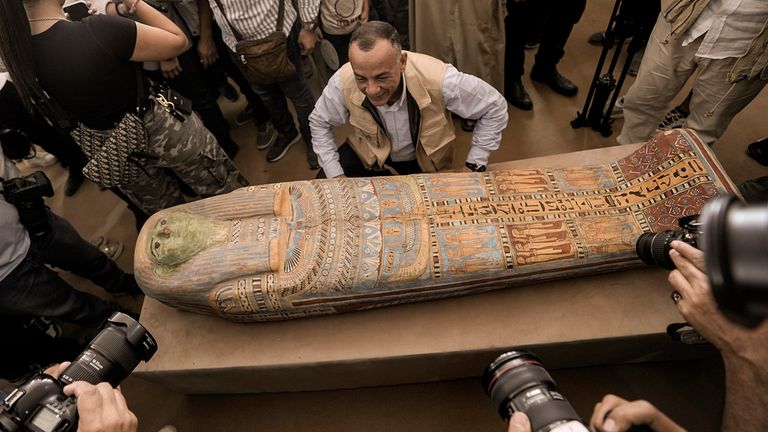/https://tf-cmsv2-smithsonianmag-media.s3.amazonaws.com/filer/20111129030007Mummy-and-Coffin-small.jpg)
Within this sarcophagus and underlying wrappings is the mummified body of a man who died 2,000 years ago (150 B.C.-50 A.D.) Photo courtesy of the Natural History Museum
Picture a mummy. You probably imagine a lurching horror-movie villain, lumbering out of a tomb with fraying cloth straps trailing behind.
The truth is quite different and no less fascinating. The Natural History Museum‘s new exhibition, “Eternal Life in Ancient Egypt,” reveals that Egyptians made mummies of loved ones, exotic animals and even pets as a means of communicating with the gods—and preserving the body to journey through the afterlife and reunite with the soul.
These mummies and associated artifacts, says curator Lana Troy of Uppsala University in Sweden, can serve as a valuable portal into the Egyptian belief system. Tentkhonsu—a female human mummy on display in the gallery—and the sarcophagus in which she was buried are covered with inscriptions and images that convey details of the Egyptians’ beliefs about life after death.

“This coffin is a product of a long tradition,” Troy says. “Perhaps the most interesting thing, for me, was discovering the way that the pictures actually fit together. They aren’t a compilation of scenes, but rather a narrative.” The detailed paintings that wrap around the outside of the sarcophagus and continue into the interior show the stages of the Egyptian afterlife, moving from death to judgement, the journey through the netherworld, and eventual rebirth.
“These were designed not as static objects, but as agents of resurrection,” says Troy. “They’re actively involved—by depicting the resurrection, showing it step by step, and placing gods in certain positions. It’s feeding into the energy of the coffin as a place where the dead are going to be revived.”
Perhaps even more than the human mummies, the dozens of animal mummies on display—ranging from tiny crocodile hatchlings to hawks to an enormous bull—most fully illustrate the importance of mummification in everyday Egyptian religious ritual. “If you go to a church, and you’re Catholic, you light a candle, and that is your offering,” says Salima Ikram of the American University in Cairo, who also curated the exhibit. “The Egyptians had animal mummies. The idea was that this creature would go and transfer the information to the god, and the god was more likely to hear you.”
The array of animal mummies also tell us about Egyptian social class and status. “If you were a peasant, you would probably pick up a cat of your own and try and wrap it or just give it to the priest,” Ikram says. Some of the more ornate mummies in the show—such as a bronze statue of the god Horus, which probably once contained a bird mummy—likely came from a wealthy family, perhaps seeking to flaunt its high social status.
Legions of workshops created these tokens of piety by the dozen, with mummy industries often based around temple complexes to sell their wares to visiting worshippers. But recent advances in CT scanning have revealed an unexpected surprise about many of these “mummies”: they’re entirely empty.
“With this baboon, you look inside, and its completely fake,” says Ikram. “Baboons were really hard to come by, particularly in this time period, because they had to be imported from Sub-saharan Africa and moved up into the Nile River Valley, so people would make fakes and say, ‘there’s a real baboon inside.’” Other mummies on display, while not empty, include only fragments of animals, so that rare creatures might be split apart and used to create multiple items.
Advanced scanning technologies and forensic techniques were also used to gain information about a pair of the human mummies in the exhibition. Getting an up-close look at bone tissue helps researchers determine the sex and age of these corpses, and examining the details of the mummification process can also tell us about the social class of an individual. “These X-rays and CT scans completely change the way we look at the mummies,” Ikram says. “Our understanding of them is now so much greater.”

“Eternal Life in Ancient Egypt” is a new permanent display at the Natural History Museum.
Get the latest on what’s happening At the Smithsonian in your inbox.
Filed Under: Nature